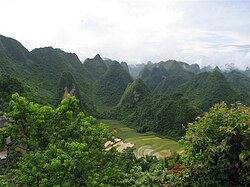Fengshan County, Guangxi
|
Fengshan County 凤山县 |
|
|---|---|
| County | |

Peak-cluster depressions
|
|
| Coordinates: 24°33′N 107°03′E / 24.550°N 107.050°ECoordinates: 24°33′N 107°03′E / 24.550°N 107.050°E | |
| Country | People's Republic of China |
| Region | Guangxi |
| Prefecture-level city | Hechi |
| County seat | Fengcheng (凤城镇) |
| Area | |
| • Total | 1,738 km2 (671 sq mi) |
| Elevation | 484 m (1,588 ft) |
| Population (2009) | |
| • Total | 215,000 |
| • Density | 120/km2 (320/sq mi) |
| Time zone | China Standard (UTC+8) |
| Postal code | 547600 |
| Area code(s) | 0778 |
| Website | http://www.gxfsx.gov.cn/index.html |
Fengshan County (simplified Chinese: 凤山县; traditional Chinese: 鳳山縣; pinyin: Fèngshān Xiàn; literally: "phoenix mountain", zhuang: Fonghsan Yen) is a county of Guangxi, China. It is under the administration of Hechi City.
Fengshan has one town, Fengcheng (凤城镇), and ten townships:
Fengshan County is located in the northwest of Guangxi. The county takes its name from the shape of the mountain range in this region, which resembles a phoenix spreading its wings. The county is situated on a variety of geological formations, including karst, which is a landscape formed from the dissolution of soluble rocks—including limestone, dolomite and gypsum—and is characterized by sinkholes, caves and underground drainage systems. Karst is a rare formation seen in only a few locations worldwide.
Fengshan County lies on the eastern fringe of the Yunnan-Guizhou Plateau and the terrain follows a northwest to southeast direction. 70% of the area, 1,738 square kilometres (671 sq mi), is covered by karst and arable land. The area has a subtropical monsoon climate with an average yearly temperature of 20 degrees Celsius.
Fengshan County possesses mineral resources such as gold, pyrite, sulphur, limonite and copper. The pyrite reserves are estimated to be about 7,083 tons with an average grade of 17%.
Fengshan has been described as the "kingdom of karst and the city of caves." There are more than 20 karst land formations such as huge caves, underground rivers, depressions, karst poljes, and sinkholes. According to statistics, there are 50 caves with chambers having an area of more than 2000 square meters and 19 caves with chambers that have an area that exceeds 10,000 square meters.
The largest caves are the Jiangzhou Underground Corridor, Mawangdong Cave and Gatundong Cave.
Jiangzhou Underground Corridor consists of many smaller caves, shafts and underground rivers. The corridor is 37,939 km (23,574 mi) and has an average slope gradient of 9°. The cave was developed in the Permian Period.
...
Wikipedia
